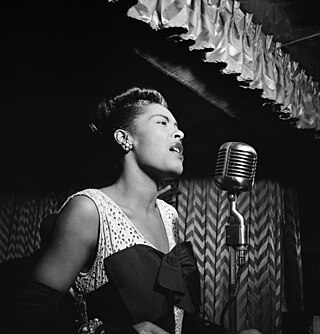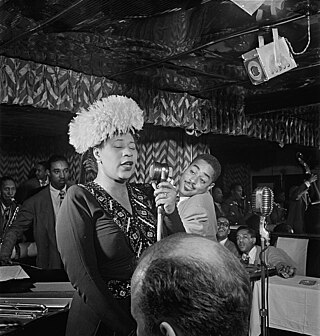Related Research Articles

Blues is a music genre and musical form that originated amongst African-Americans in the Deep South of the United States around the 1860s. Blues incorporated spirituals, work songs, field hollers, shouts, chants, and rhymed simple narrative ballads from the African-American culture. The blues form is ubiquitous in jazz, rhythm and blues, and rock and roll, and is characterized by the call-and-response pattern, the blues scale, and specific chord progressions, of which the twelve-bar blues is the most common. Blue notes, usually thirds, fifths or sevenths flattened in pitch, are also an essential part of the sound. Blues shuffles or walking bass reinforce the trance-like rhythm and form a repetitive effect known as the groove.

A song is a musical composition performed by the human voice. The voice often carries the melody using patterns of sound and silence. Songs have a structure to them, such as the common ABA form, and are usually made of sections that are repeated or performed with variation later. A song without instruments is said to be a cappella.

Originating in vocal jazz, scat singing or scatting is vocal improvisation with wordless vocables, nonsense syllables or without words at all. In scat singing, the singer improvises melodies and rhythms using the voice solely as an instrument rather than a speaking medium. This is different from vocalese, which uses recognizable lyrics that are sung to pre-existing instrumental solos.

A jazz band is a musical ensemble that plays jazz music. Jazz bands vary in the quantity of its members and the style of jazz that they play but it is common to find a jazz band made up of a rhythm section and a horn section.

Vocal music is a type of singing performed by one or more singers, either with instrumental accompaniment, or without instrumental accompaniment, in which singing provides the main focus of the piece. Music which employs singing but does not feature it prominently is generally considered to be instrumental music as is music without singing. Music without any non-vocal instrumental accompaniment is referred to as a cappella.

Singing is the act of creating musical sounds with the voice. A person whose profession is singing is called a singer, artist or vocalist. Singers perform music that can be sung with or without accompaniment by musical instruments. Singing is often done in an ensemble of musicians, such as a choir. Singers may perform as soloists or accompanied by anything from a single instrument up to a symphony orchestra or big band. Different singing styles include art music such as opera and Chinese opera, Indian music, Greek music, Japanese music, and religious music styles such as gospel, traditional music styles, world music, jazz, blues, ghazal, and popular music styles such as pop, rock, and electronic dance music.
In music, an ostinato is a motif or phrase that persistently repeats in the same musical voice, frequently in the same pitch. Well-known ostinato-based pieces include classical compositions such as Ravel's Boléro and the Carol of the Bells, and popular songs such as Donna Summer and Giorgio Moroder's "I Feel Love" (1977), Henry Mancini's theme from Peter Gunn (1959), The Who's "Baba O'Riley" (1971), The Verve's "Bitter Sweet Symphony" (1997), and Flo Rida's "Low" (2007).
Vocalese is a style of jazz singing in which words are added to an instrumental soloist's improvisation.
In music, call and response is a compositional technique, often a succession of two distinct phrases that works like a conversation in music. One musician offers a phrase, and a second player answers with a direct commentary or response. The phrases can be vocal, instrumental, or both. Additionally, they can take form as commentary to a statement, an answer to a question or repetition of a phrase following or slightly overlapping the initial speaker(s). It corresponds to the call and response pattern in human communication and is found as a basic element of musical form, such as the verse-chorus form, in many traditions.
A work song is a piece of music closely connected to a form of work, either one sung while conducting a task or one linked to a task that may be a connected narrative, description, or protest song. An example is "I've Been Working on the Railroad".

Accompaniment is the musical part which provides the rhythmic and/or harmonic support for the melody or main themes of a song or instrumental piece. There are many different styles and types of accompaniment in different genres and styles of music. In homophonic music, the main accompaniment approach used in popular music, a clear vocal melody is supported by subordinate chords. In popular music and traditional music, the accompaniment parts typically provide the "beat" for the music and outline the chord progression of the song or instrumental piece.

The lead vocalist in popular music is typically the member of a group or band whose voice is the most prominent melody in a performance where multiple voices may be heard. The lead singer sets their voice against the accompaniment parts of the ensemble as the dominant sound. In vocal group performances, notably in soul and gospel music, and early rock and roll, the lead singer takes the main vocal melody, with a chorus or harmony vocals provided by other band members as backing vocalists. Lead vocalists typically incorporate some movement or gestures into their performance, and some may participate in dance routines during the show, particularly in pop music. Some lead vocalists also play an instrument during the show, either in an accompaniment role, or playing a lead instrument/instrumental solo role when they are not singing.
Amos Leon Thomas Jr., known professionally as Leon Thomas, was an American jazz and blues vocalist, born in East St. Louis, Illinois, and known for his bellowing glottal-stop style of free jazz singing in the late 1960s and 1970s.

The field holler or field call is mostly a historical type of vocal work song sung by field slaves in the United States to accompany their tasked work, to communicate usefully, or to vent feelings. It differs from the collective work song in that it was sung solo, though early observers noted that a holler, or ‘cry’, might be echoed by other workers. Though commonly associated with cotton cultivation, the field holler was also sung by levee workers, and field hands in rice and sugar plantations. Field hollers are also known as corn-field hollers, water calls, and whoops. An early description is from 1853 and the first recordings are from the 1930s. The holler is closely related to the call and response of work songs and arhoolies. The Afro-American music form ultimately influenced strands of African American music, such as the blues and thereby rhythm and blues, as well as negro spirituals.

Jazz improvisation is the spontaneous invention of melodic solo lines or accompaniment parts in a performance of jazz music. It is one of the defining elements of jazz. Improvisation is composing on the spot, when a singer or instrumentalist invents melodies and lines over a chord progression played by rhythm section instruments and accompanied by drums. Although blues, rock, and other genres use improvisation, it is done over relatively simple chord progressions which often remain in one key.

Screaming is an extended vocal technique that is popular in "aggressive" music genres such as heavy metal, punk rock, and noise music. It is common in the more extreme subgenres of heavy metal, such as death and black metal as well as many other subgenres.
School of Jazz and Contemporary Music is the second conservatory of The New School. It is located on West 13th Street in New York City's Greenwich Village neighborhood. It was known as The New School for Jazz and Contemporary Music before it was rebranded as School of Jazz and Contemporary Music and becoming part of College of Performing Arts at The New School in 2015.
Non-lexical vocables, which may be mixed with meaningful text, are a form of nonsense syllable used in a wide variety of music. Common English examples are "la la la", "na na na" and "da da da".
Contemporary commercial music or CCM is a term used by some vocal pedagogists in the United States to refer to non-classical music. This term encompasses jazz, pop, blues, soul, country, folk, and rock styles.
Traditional sub-Saharan African harmony is a music theory of harmony in sub-Saharan African music based on the principles of homophonic parallelism, homophonic polyphony, counter-melody and ostinato-variation. Polyphony is common in African music and heterophony is a common technique as well. Although these principles of traditional African music are of Pan-African validity, the degree to which they are used in one area over another varies. Specific techniques that used to generate harmony in Africa are the "span process", "pedal notes", "rhythmic harmony", "harmony by imitation", and "scalar clusters".
References
- 1 2 "Jazz | Definition, History, Musicians, & Facts | Britannica". www.britannica.com. 2024-03-20. Retrieved 2024-04-16.
- 1 2 3 4 5 6 Yanow, Scott (2008). The Jazz Singers: The Ultimate Guide. New York, NY: Backbeat Books. pp. x–xi.
{{cite book}}: CS1 maint: date and year (link) - 1 2 3 "Work Song, Field Call & More". Timeline of African American Music. Retrieved 2024-04-26.
- ↑ Crowther, Bruce; Pinfold, Mike (1997). Singing Jazz. Miller Freeman Books. ISBN 0-87930-519-3.
- 1 2 3 4 5 Spradling, Diana; Binek, Justin (June 2015). "Pedagogy for the Jazz Singer". The Choral Journal. 55 (11). American Choral Directors Association: 6–17 – via JSTOR.
- ↑ Moline, Lara Marie (2019). Vocal Jazz in the Choral Classroom: A Pedagogical Study (DMA dissertation). University of Northern Colorado. Paper 576 – via Digital UNC.